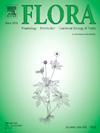亚马逊树木对长期实验干旱的功能调整是有限的,并且依赖于物种
IF 1.8
4区 生物学
Q3 ECOLOGY
引用次数: 0
摘要
水的可用性影响着热带森林的分布和功能,但物种如何应对未来的干旱条件还不确定。在热带森林eSecaFlor进行的历时22年的最长通落排除试验(TFE)表明,长期的土壤水分减少导致了一种新的生态水文状态,由于生物量减少,干旱胁迫最小,需要重新评估这种新状态下的物种功能调整。在这项研究中,我们调查了eSecaFlor TFE中的东亚马逊树种是否会根据长期的土壤水分亏缺而调整其功能性状,以及这些调整是否在物种之间存在差异。我们选择了在对照区和TFE区生长的9种植物,测量了与叶片水分状态(黎明前和中午水势)、叶片和木材经济(比叶面积和木材密度)以及与水力效率(导管直径和数量、水力比电导率)相关的木质部解剖性状的功能性状。我们发现,物种并没有调整它们的大部分特征来响应TFE。然而,在黎明前水势和木材密度方面,我们发现了物种特异性的调整,但这些调整不是单向的,有些物种的性状值增加,有些物种的性状值减少。由于调整有限,TFE没有引起树木功能空间的移位。我们的研究强调需要进一步研究控制物种依赖的干旱响应的机制,以及在物种干旱响应不均匀的情况下,亚马逊森林物种群落如何受到影响。本文章由计算机程序翻译,如有差异,请以英文原文为准。
Amazonian trees functional adjustments to long term experimental drought are limited and species dependent
Water availability influences the distribution and functioning of tropical forests, yet there is uncertainty about how species will respond to future drier conditions. The longest throughfall exclusion experiment (TFE) in tropical forest, eSecaFlor, which run for 22 years, showed long term soil water reduction resulted in a new eco-hydrological state with minimal drought stress due to reduced biomass, requiring the re-evaluation of species functional adjustments under this new state. In this study, we investigated whether Eastern Amazon tree species in the eSecaFlor TFE adjust their functional traits in response to long-term soil water deficit and whether these adjustments differ across species. We selected 9 species that occur in the control and TFE plots and we measured functional traits related to leaf water status (predawn and midday water potential), leaf and wood economics (specific leaf area and wood density) and xylem anatomical traits related to hydraulic efficiency (vessel diameter and number, and hydraulic specific conductivity). We found that species did not adjust most of their traits in response to the TFE. However, we found species-specific adjustments in predawn water potential and wood density, but those adjustments were not unidirectional, with some species increasing and others decreasing their trait values. Because of limited adjustments, there was no shift in tree functional space caused by the TFE. Our study highlights the need to further study what mechanisms controls species-dependent drought responses and how the Amazon forest species community may be affected given drought responses of species is not uniform.
求助全文
通过发布文献求助,成功后即可免费获取论文全文。
去求助
来源期刊

Flora
生物-植物科学
CiteScore
3.30
自引率
10.50%
发文量
130
审稿时长
54 days
期刊介绍:
FLORA publishes original contributions and review articles on plant structure (morphology and anatomy), plant distribution (incl. phylogeography) and plant functional ecology (ecophysiology, population ecology and population genetics, organismic interactions, community ecology, ecosystem ecology). Manuscripts (both original and review articles) on a single topic can be compiled in Special Issues, for which suggestions are welcome.
FLORA, the scientific botanical journal with the longest uninterrupted publication sequence (since 1818), considers manuscripts in the above areas which appeal a broad scientific and international readership. Manuscripts focused on floristics and vegetation science will only be considered if they exceed the pure descriptive approach and have relevance for interpreting plant morphology, distribution or ecology. Manuscripts whose content is restricted to purely systematic and nomenclature matters, to geobotanical aspects of only local interest, to pure applications in agri-, horti- or silviculture and pharmacology, and experimental studies dealing exclusively with investigations at the cellular and subcellular level will not be accepted. Manuscripts dealing with comparative and evolutionary aspects of morphology, anatomy and development are welcome.
 求助内容:
求助内容: 应助结果提醒方式:
应助结果提醒方式:


